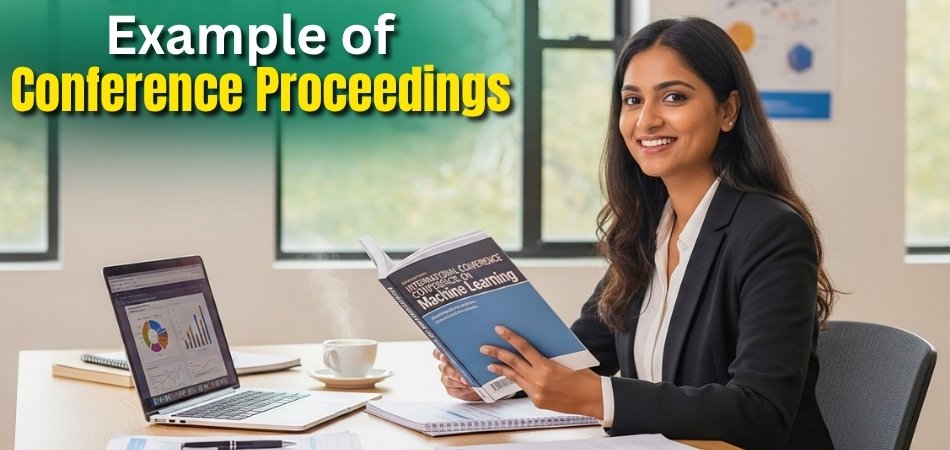Conference proceedings are official collections of papers, abstracts, and findings presented at academic or professional events. They document the key discussions, discoveries, and innovations shared by researchers, serving as a reliable source of updated knowledge in various fields.
The example of conference proceedings usually includes reviewed research papers, summaries, and case studies presented during the event. They help scholars reference past work, track progress in a specific area, and understand current academic trends. Many are later published in journals, books, or online databases for global access.
If you’re curious to see how these records are organized, explore the detailed example of conference proceedings below to understand their structure, format, and importance in academic publishing.
Example of Conference Proceedings
Conference proceedings compile research papers, summaries, and case studies presented during an event, creating a lasting record of shared knowledge. They help readers access new ideas, findings, and discussions long after the conference ends. Here’s a closer look at the main components that make up a well-structured and informative conference proceeding:

Research Papers
Research papers form the core of any conference proceedings. They include complete, peer-reviewed studies presenting original findings, models, or methods. Each paper follows a formal academic format, usually consisting of an abstract, introduction, methodology, results, and conclusion. These papers contribute new knowledge to their respective fields and represent the conference’s most significant scholarly output. They not only showcase innovation but also provide a foundation for further academic discussion and citation.
Summaries
Summaries, often called abstracts, provide short, focused overviews of each paper or presentation. They briefly outline the objectives, methods, and main findings, typically within 150–300 words. Abstracts help readers quickly identify relevant research without reading the entire document. By offering a snapshot of the paper’s content, they make the proceedings more accessible for those scanning through multiple studies.
Case Studies
Case studies highlight how theoretical research is applied in real-life situations. They present detailed accounts of projects, organizational challenges, or experiments that demonstrate practical implications of research. Each case study includes background information, data analysis, implementation methods, and observed results. This section connects academic theory with real-world impact, providing lessons that can guide future practices or research directions.
Discussion and Review Sections
This part summarizes key points from expert panels, Q&A sessions, and open discussions held during the conference. It captures diverse perspectives and highlights ongoing debates within the field. These reviews allow readers to understand how scholars and practitioners interpret findings differently, reflecting the collaborative nature of academic exchange. Such discussions often inspire new research ideas or policy recommendations.
Poster and Short Paper Abstracts
Poster and short paper abstracts are concise versions of ongoing or preliminary research projects. They showcase early results, innovative approaches, or prototypes. Often presented by emerging researchers, these abstracts encourage participation and knowledge sharing at various academic levels. Their inclusion adds variety and supports future publication opportunities as the studies develop further.
Editorial Notes and Preface
Most proceedings open with editorial notes or a preface written by the organizing committee or editors. This section provides context about the conference theme, goals, and significance. It may also acknowledge contributors, sponsors, and reviewers who supported the event. The preface helps readers understand the vision behind the proceedings and the importance of the topics covered.
Acknowledgments and References
The final section includes acknowledgments and comprehensive references. It recognizes contributors, funding organizations, and reviewers who made the publication possible. References provide detailed citation lists from each paper, ensuring academic credibility and allowing readers to explore sources further. Together, they add transparency and uphold scholarly standards within the publication.
Who Publishes Conference Proceedings?
Conference proceedings don’t just record research; they also need reliable publishers to make that knowledge accessible. These publications are handled by academic bodies, universities, or professional publishers to ensure quality and reach. Let’s look at who typically publishes conference proceedings and how they make these valuable records available to a global audience.
IEEE International Conference on Robotics and Automation (ICRA)
- Published annually by the IEEE, this proceedings volume collects hundreds of robotics research papers.
- Each paper includes author names, abstracts, methods, findings, and references.
- The collection is widely cited and considered a key source for robotics innovation.
ACM SIGCHI Conference on Human Factors in Computing Systems (CHI)
- Proceedings include research on usability, interaction design, and human-computer interaction.
- Published digitally through the ACM Digital Library.
- Readers gain insights into new technologies shaping everyday user experiences.
Proceedings of the National Academy of Sciences (PNAS) Conference Series
- Contains research presented at various scientific meetings across biology, chemistry, and physics.
- Known for rigorous peer review and lasting academic impact.
- Provides structured documentation of breakthrough discoveries for broad audiences.
International Conference on Machine Learning (ICML)
- One of the largest AI conferences, the proceedings are released online.
- Includes cutting-edge studies on algorithms, models, and applications.
- Highly accessible, ensuring fast distribution of new research in artificial intelligence.
American Society of Civil Engineers (ASCE) Conference Proceedings
- Features engineering studies from global conferences on structural, environmental, and construction engineering.
- Available in print and digital formats for professionals worldwide.
- Helps practitioners apply research findings in real-world projects.
Why are Conference Proceedings Important?
Conference proceedings are more than printed papers. They bring research findings together, share new knowledge, and highlight innovation. These collections connect people, foster collaboration, and preserve valuable studies for future learning across fields and industries. Let’s explore why conference proceedings play such an essential role in academia and professional research.
Preserving Research Permanently
- Proceedings record new studies that might never appear elsewhere, giving researchers lasting documentation of their work. They ensure future scholars can revisit findings and trace how knowledge evolved across disciplines over time.
- Authors gain recognition because their work is permanently stored, allowing others to reference or build upon ideas. This preservation ensures credit remains visible within the research community for many years.
- Without conference proceedings, many ideas would vanish after presentation, leaving valuable insights unrecorded. Proceedings transform temporary discussions into permanent contributions to knowledge.
Encouraging Collaboration Opportunities
- Sharing studies during conferences sparks professional conversations that lead to collaboration. Researchers exchange views, ideas, and sometimes join efforts across institutions.
- Proceedings act like bridges because they provide documented insights accessible to anyone, even beyond the event. This accessibility helps researchers from various countries connect with similar-minded individuals.
- Documented research encourages networking because people notice related work and contact authors. These interactions often result in exciting joint projects.
Improving Academic Visibility
- Researchers gain recognition when their work appears in proceedings. This exposure increases opportunities for invitations, grants, and projects.
- Proceedings are indexed in libraries and databases, which makes research visible to global audiences. Visibility supports professional growth.
- High visibility improves citation rates. The more people read proceedings, the more likely they are to acknowledge contributions.
Supporting Knowledge Distribution
- Proceedings spread new research across many audiences, ensuring discoveries travel beyond the immediate conference attendees. This wide reach benefits academia.
- Findings reach students, teachers, and professionals who could not attend, making knowledge accessible globally. Accessibility supports inclusion.
- Because proceedings exist in both print and digital forms, they strengthen worldwide communication channels. This distribution keeps research alive.
Enhancing Professional Credibility
- Publishing in peer-reviewed proceedings shows strong academic standards. This credibility builds trust among readers who evaluate research quality.
- Institutions value proceedings as evidence of scholarly contribution, rewarding faculty for published work. This recognition boosts professional standing.
- Employers see proceedings as proof of expertise, giving researchers better opportunities in teaching, consulting, or project leadership.
Showcasing International Knowledge Exchange
- Conferences happen worldwide in countries like Canada, Germany, Japan, and the United States. Proceedings capture international collaboration efforts.
- When exploring opportunities, many scholars look at upcoming conferences in Canada or similar global hubs. Such proceedings extend reach.
- International proceedings reveal cultural diversity in academic thought, enriching the research landscape with varied perspectives and insights.
Promoting Innovation Across Disciplines
- New ideas presented at conferences often inspire future studies. Proceedings document these sparks, encouraging continued innovation.
- Researchers from unrelated fields may discover surprising connections, creating cross-disciplinary solutions. These unexpected synergies drive groundbreaking advancements.
- By collecting different viewpoints, proceedings ensure innovation grows in both academic and applied settings. Creativity thrives through diversity.
Strengthening Student Learning
- Students use proceedings to learn current developments, gaining real-world context beyond traditional textbooks. They benefit from practical exposure.
- Proceedings introduce learners to research methods, preparing them for independent academic projects. This practice strengthens educational experiences.
- Access to proceedings inspires students to conduct research themselves. Participation in future conferences becomes a motivating academic goal.
Standard Structure of a Paper in Conference Proceedings
When you read research papers, you’ll notice they usually follow a simple and organized format. This makes it easier for readers to find the exact part they need quickly. Every section has its own purpose that builds the study clearly. Knowing this structure helps readers understand what the paper is trying to explain.
Title and Authors
The title is the first thing people see, so it tells them what the paper is about. A clear title makes it easy to guess the main topic before reading the full text. Just below the title, you’ll find the names of the authors who wrote the paper. These names often include their colleges or organizations. This section sets the stage for everything that comes next.
Abstract
The abstract is like a quick summary of the whole paper in a short paragraph. It usually includes the problem studied, methods used, and important findings. Readers can decide if the paper is useful just by reading the abstract. It saves time and makes it easier to compare multiple papers. That’s why abstracts are short but very important.
Introduction
The introduction explains the background and why the study was done. Authors use this section to highlight the problem and its importance. It also shows what earlier research has already done in that area. By reading it, you understand the reason behind the study. This part always builds curiosity for the details ahead.
Methodology
This section talks about how the research was done in detail. It explains the tools, steps, and techniques used by the authors. Readers can follow the same process if they want to repeat the study. Clear methods make the research more reliable. Without this, no one can check if the results are trustworthy.
Results
The results section shows the findings after using the methods described earlier. Data is often presented through tables, charts, or graphs. This makes it easier to see what the research proved or discovered. The facts are presented here without any deep explanation. Readers just get the direct outcome of the study.
Discussion
In this section, the authors explain what the results mean in simple words. They connect the findings with earlier research and highlight their importance. If there were surprises, they discuss possible reasons behind them. Sometimes, they also reflect on the broader meaning of conference proceedings, showing how the published findings contribute to academic understanding.
Conclusion
The conclusion wraps up the whole paper by summarizing everything quickly. Authors usually restate the problem, methods, and major findings. It also explains how the results can be useful in real life. Sometimes suggestions for future research are added here too. The conclusion makes the paper feel complete and satisfying.
References
This is the final section where all sources used in the paper are listed. Authors give credit to earlier studies or books that supported their work. References also guide readers who want to explore more details. Having references shows the research is connected to trusted work. It adds honesty and reliability to the paper.
Here are some different samples of papers in conference proceedings
Robotics and Automation Paper
- Title: “Autonomous Drone Navigation in Urban Environments”
- Conference: IEEE International Conference on Robotics and Automation (ICRA)
- Details: The paper presents algorithms for drones to fly safely in cities, avoiding obstacles like buildings and traffic. It explains methods, shows results through simulations, and discusses real-world uses such as delivery services and rescue operations.
Computer Science Paper
- Title: “Improving User Experience with Voice-Activated Systems”
- Conference: ACM SIGCHI Conference on Human Factors in Computing Systems (CHI)
- Details: This paper focuses on how people interact with voice assistants like Alexa and Siri. It explores design improvements, studies user feedback, and suggests new features to make systems more helpful and natural.
Environmental Engineering Paper
- Title: “Water Recycling Techniques for Sustainable Cities”
- Conference: American Society of Civil Engineers (ASCE) International Conference
- Details: The study introduces advanced methods for treating and reusing wastewater in urban areas. It highlights results from pilot projects and explains how these systems reduce waste and save resources.
Artificial Intelligence Paper
- Title: “Efficient Neural Networks for Medical Imaging”
- Conference: International Conference on Machine Learning (ICML)
- Details: The paper describes machine learning models that can detect diseases from medical scans faster and more accurately. Results show improved performance compared to older systems, making healthcare diagnosis quicker and more reliable.
Education Research Paper
- Title: “Gamified Learning for Better Student Engagement”
- Conference: International Conference on Education and Learning Technologies
- Details: This paper shows how game-based methods can improve classroom participation. It shares surveys, testing outcomes, and explains how teachers can use these tools for better results.
Formatting Guidelines Commonly Followed
When preparing a paper for conference proceedings, writers need to follow specific formatting rules. These rules make papers look consistent across conferences. They also help readers easily understand the content without confusion or distraction. Good formatting keeps the focus on research instead of presentation. Let’s look at the key formatting standards commonly required when preparing papers for conference publication.
- Citation Style: Conference papers usually require a fixed style like APA or IEEE. Following one style ensures readers can quickly locate referenced sources.
- Font Choice: Most conferences prefer simple fonts like Times New Roman or Arial. Clear font choices help maintain professional readability throughout papers.
- Word Count: Every conference sets a word limit, often between 3000 and 6000. Respecting this limit keeps papers concise, focused, and structured.
- Figures Use: Authors add graphs, charts, and diagrams to explain results. Proper captions and numbering help readers understand figures without confusion.
- Tables Layout: Tables are used to organize data clearly for quick comparison. Neat formatting ensures readers understand values and categories instantly.
- Page Layout: Margins, spacing, and alignment must stay uniform throughout. Conferences usually provide templates that guide writers on the exact layout structure.
- Section Order: A clear order is followed: title, abstract, introduction, methods, results, discussion, conclusion, and references. This sequence ensures smooth reading flow.
How Are Conference Proceedings Compiled and Published?
When research conferences take place, many interesting papers are presented by different authors. These papers cannot just stay inside the conference halls. To make them useful, organizers collect and publish them. This way, the knowledge becomes available to readers everywhere. Here are the main steps involved in compiling and publishing conference proceedings:
Call for Papers
Organizers first announce that they are accepting papers from researchers. This announcement is called a “call for papers” and it spreads widely. Interested authors submit their work following the provided rules. This step ensures a wide range of research gets included.
Paper Submission
Researchers prepare their papers according to specific guidelines and then upload them online. Guidelines usually include formatting, length, and citation style. Authors carefully follow these requirements to avoid rejection. Submissions are then collected in a system for review.
Peer Review
Every submitted paper goes through a review process by experts in the same field. These experts check quality, accuracy, and originality. If something needs improvement, authors are asked to revise their papers. Only good-quality research is accepted for publication.
Editing and Formatting
Once papers are approved, editors make sure they all follow the same structure and style. This gives the collection a professional look. Editors also check spelling, grammar, and figures for errors. The structure of conference proceeding becomes very clear at this stage.
Final Compilation
After editing, all accepted papers are arranged in order. They might be grouped by topics or research categories. A table of contents is created for easy navigation. This combined collection is now ready to be published.
Publishing Online
Most proceedings are uploaded to digital libraries or official websites. Online publishing makes them available worldwide. Researchers can download them anytime without needing a physical copy. This helps knowledge spread faster to more people.
Print Versions
Some conferences still release printed books with all the papers. These copies are useful for libraries and collectors. A printed version feels formal and serves as a permanent record. Even in the digital age, print adds value.
Common Mistakes in Conference Proceedings Papers
Writing a paper for conference proceedings needs focus and attention to detail. Many authors rush and end up making avoidable errors. These mistakes can reduce the impact of the research and confuse the readers. Knowing them helps writers prepare stronger papers.
- Unclear Abstracts: Abstracts that are vague leave readers unsure about the research focus. Strong abstracts highlight purpose, methods, and findings within a few sentences.
- Weak Introductions: Introductions lacking context fail to explain why the study matters. A clear introduction builds interest and sets the research direction.
- Poor Formatting: Ignoring formatting rules makes papers look messy and unprofessional. Clean layouts improve readability and keep research consistent across proceedings.
- Inaccurate References: Citations that are incomplete or wrong reduce credibility. Proper referencing ensures sources are traceable, reliable, and helpful for further study.
- Overloaded Data: Including unnecessary tables and figures makes papers confusing. Balanced data presentation highlights only key results while keeping text readable.
- Weak Conclusions: Conclusions that repeat earlier content add little value. A strong conclusion summarizes findings and suggests possible real-world applications effectively.
- Language Errors: Grammar mistakes or awkward sentences distract readers. Clear and simple language ensures ideas are communicated smoothly without unnecessary complications.
Tips for Writing a Strong Conference Proceedings Paper
Writing for conference proceedings may look difficult, but it becomes easier with the right approach. A strong paper stands out because it is clear and well-structured. Readers like simple writing that explains big ideas without confusion. Following smart tips can make any paper shine.
Understand Guidelines
Every conference has its own set of rules for paper submission. Authors must read and follow them carefully to avoid rejection. Guidelines cover font, format, word count, and style requirements. Ignoring them can make even good research appear unprofessional.
Keep It Clear
A strong paper always explains ideas in simple and direct sentences. Avoid adding unnecessary words or confusing details. Readers appreciate clarity because it makes the content easier to follow. Straightforward writing helps highlight the real strength of the research.
Focus on Contributions
The most important part of any paper is the unique contribution it offers. Readers want to know what is new. Highlight findings that make your research special and useful. Strong contributions leave a lasting impression on both judges and readers.
Write a Strong Abstract
The abstract works like a window to the entire paper. It must explain the purpose, method, and findings clearly. A good abstract helps readers quickly decide if the paper is useful. Without clarity here, readers might skip the work entirely.
Organize Properly
A paper must follow a logical order so readers can move smoothly from one section to another. Use headings like introduction, method, results, and conclusion. Each section should clearly serve its purpose. A well-organized paper feels easier to read and understand.
Use Data Wisely
Figures and tables make research stronger when used correctly. They must explain important points without crowding the paper unnecessarily. Always add captions to guide readers through the data. Well-presented information makes your research more convincing and trustworthy.
Revise and Edit
Writing a paper does not end with the first draft. Careful editing removes mistakes and makes ideas stronger. Authors should check grammar, spelling, and flow before submission. Reviewing ensures the paper looks professional and easy to understand.
Frequently Asked Questions about Example of Conference Proceedings
Conference proceedings often raise many questions for readers who are new to academic research. They are collections of research papers presented at scholarly events. Below are eight frequently asked questions with answers that explain the topic in simple words.
What Is the Difference Between Conference Proceedings and Journals?
Conference proceedings are collections of papers presented at conferences, while journals publish ongoing peer-reviewed research regularly. Proceedings capture research presented during a specific event, while journals focus on continuous contributions across many issues throughout the year.
Do All Conferences Publish Proceedings?
Not every conference produces proceedings, but major academic and technical events usually do. Smaller conferences might only provide abstracts or summaries. Proceedings add credibility by documenting contributions, making them useful references for researchers and students worldwide.
Where Can Conference Proceedings Be Found?
Conference proceedings are usually available through online libraries, official conference websites, or databases like IEEE Xplore and ACM Digital Library. Some proceedings are also sold as printed volumes, while others are shared freely in open-access repositories for wider availability.
How Do Proceedings Help Students?
Proceedings help students by giving them access to the latest research in their field of study. They learn about new methods, ideas, and real-world applications, making their understanding stronger and more practical compared to traditional textbooks.
Are Conference Proceedings Always Peer-Reviewed?
Most conference proceedings undergo peer review, but the depth varies across events. Some conferences have strict reviews like journals, while others focus on faster publication. Review processes help ensure the research included is credible, accurate, and relevant to readers.
Can Conference Proceedings Be Cited in Research?
Yes, conference proceedings are citable sources in research papers. They are valuable because they contain original, up-to-date studies. Researchers often use them to show early findings or highlight new ideas before they appear in full journal articles.
Do Proceedings Count for Academic Growth?
Yes, proceedings often contribute to academic growth by improving a researcher’s profile. Institutions consider them as evidence of scholarly activity. Citations from proceedings strengthen reputations, helping authors gain recognition, funding opportunities, and chances for future collaborative projects.
What Makes Proceedings Valuable for Professionals?
Professionals use proceedings to keep up with advances in their industry. They apply research findings in real projects, guiding innovation. Proceedings allow them to access practical case studies, technical improvements, and expert discussions that influence decision-making in real-world work.
Wrap Up
Conference proceedings are important because they keep research safe, share new ideas, and make knowledge available to everyone. They do not let important studies disappear after the event ends. Instead, they save them for people to use later. Each part, from writing style to review, makes the papers clear and useful.
An example of conference proceedings can be seen in collections like IEEE or ACM, where many research papers are gathered together. These records help people learn new things, follow important changes, and connect with others. They are simple but powerful tools for education and research growth.








